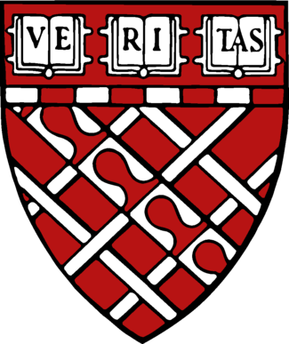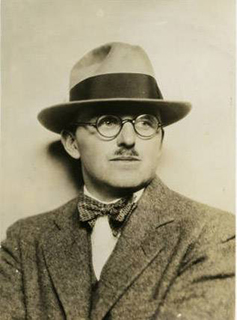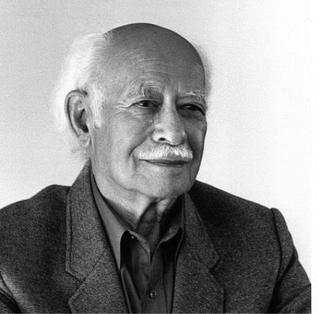The year 1953 in architecture involved some significant events.

The Ibero-American University, also referred to by its acronym UIA but commonly known as Ibero or La Ibero, is a private, Catholic, Mexican higher education institution, sponsored by the Mexican province of the Society of Jesus (Jesuit). In 2009, the UIA received the SEP-ANUIES Prize as the best private university in Mexico. The Ibero's flagship campus is located in the Santa Fe district of Mexico City.

Jicarilla Apache, one of several loosely organized autonomous bands of the Eastern Apache, refers to the members of the Jicarilla Apache Nation currently living in New Mexico and speaking a Southern Athabaskan language. The term jicarilla comes from Mexican Spanish meaning "little basket", referring to the small sealed baskets they used as drinking vessels. To neighboring Apache bands, such as the Mescalero and Lipan, they were known as Kinya-Inde.

The Harvard Graduate School of Design (GSD) is the graduate school of design at Harvard University, a private research university in Cambridge, Massachusetts. It offers master's and doctoral programs in architecture, landscape architecture, urban planning, urban design, real estate, design engineering, and design studies.

Antoine Predock is an American architect based in Albuquerque, New Mexico. He is the principal of Antoine Predock Architect PC, the studio he founded in 1967.

John Gaw Meem IV was an American architect based in Santa Fe, New Mexico. He is best known for his instrumental role in the development and popularization of the Pueblo Revival Style and as a proponent of architectural Regionalism in the face of international modernism. Meem is regarded as one of the most important and influential architects to have worked in New Mexico.

The Pueblo Revival style or Santa Fe style is a regional architectural style of the Southwestern United States, which draws its inspiration from Santa Fe de Nuevo México's traditional Pueblo architecture, the Spanish missions, and Territorial Style. The style developed at the beginning of the 20th century and reached its greatest popularity in the 1920s and 1930s, though it is still commonly used for new buildings. Pueblo style architecture is most prevalent in the state of New Mexico; it is often blended with Territorial Revival architecture.

Pablita Velarde born Tse Tsan was an American Pueblo artist and painter.

Beverly Willis was an American architect who played a major role in the development of many architectural concepts and practices that influenced the design of American cities and architecture. Willis' achievements in the development of new technologies in architecture, urban planning, public policy and her leadership activities on behalf of architects are well known. Her best-known built-work is the San Francisco Ballet Building in San Francisco, California. She was a co-founder of the National Building Museum, in Washington, D.C., and founder of the Beverly Willis Architecture Foundation, a non-profit organization working to change the culture for women in the building industry through research and education.

Joseph Stein was an American architect and a major figure in the establishment of a regional modern architecture in the San Francisco Bay area in the 1940s and 1950s during the early days of the environmental design movement. In 1952, he moved to India and in 1955 was tasked with the planning of Durgapur in West Bengal, India along with Benjamin Polk. He was commissioned with this task in order to facilitate the establishment of Durgapur Steel Plant later on in 1959 followed by the Durgapur Steel City and Township. He is noted for designing several important buildings in India, most notably in Lodhi Estate in Central Delhi, nicknamed "Steinabad" after him, and where today the 'Joseph Stein Lane', is the only road in Delhi named after an architect. He is also famous for being the architect of the scenic Indian Institute of Management Kozhikode's campus. The Government of India awarded him the fourth highest civilian award of Padma Shri in 1992. His works remain even more relevant in the modern context as need for sustainable and humane architecture is felt.

The architecture of Mexico reflects the influences of various cultures, regions, and periods that have shaped the country's history and identity. In the pre-Columbian era, distinct styles emerged that reflected the distinct cultures of the indigenous peoples of Mexico, particularly in the architecture of Mesoamerica. During the colonial era, the region was transformed by successive styles from Europe. With the foremost style during this era being Mexican Baroque.
Eleanor Manning O'Connor was an American architect and educator passionate about the creation of decent public housing for all.

Margarete Bagshaw was an American artist known for her paintings and pottery. She was descended from the Tewa people of K'apovi or the Kha'p'oo Owinge, Santa Clara Pueblo, New Mexico.

Raj Rewal is a leading Indian architect.

The Inaja Band of Diegueño Mission Indians of the Inaja and Cosmit Reservation is a federally recognized tribe of Kumeyaay Indians, who are sometimes known as Mission Indians.
The American Indian Science and Engineering Society (AISES) is a 501(c)(3) non-profit professional association with the goal of substantially increasing American Indian, Alaskan Native, Native Hawaiian, Pacific Islander, First Nation and other indigenous peoples of North America representation in the fields of science, technology, engineering, math (STEM) and other related disciplines. Its headquarters is located in Albuquerque, New Mexico. As of May 1, 2013, Sarah EchoHawk is the Chief Executive Officer.
Wanda Dalla Costa is a practicing architect and professor who has been co-designing with North American indigenous communities for nearly two decades. Her teaching and research focuses include indigenous place-keeping, culturally responsive design, sustainable housing, and climate resiliency in architecture. Dalla Costa currently teaches at Arizona State University as Institute Professor and associate professor in The Design School and the School of Sustainable Engineering and the Built Environment. She is a member of Saddle Lake Cree Nation and the first First Nations woman architect in Canada. She is founding principal and owner of the firm, Redquill Architecture Inc., which is based in Phoenix, Arizona. She was one of eighteen indigenous architects representing Canada in the Venice Architecture Biennale 2018.
Denby Deegan, also known as Surrounded by Enemy, was a notable Native American architect in the United States and a founding member of the American Indian Council of Architects and Engineers. Deegan was a member of the Three Affiliated Tribes, known as the Mandan, Hidatsa, and Arikara Nation, and his architectural and design work focused on themes and motifs from his culture and heritage.

Van Dorn Hooker was an American architect and the University Architect for the University of New Mexico from 1963 to 1987.
Mahendra Raj was an Indian structural engineer and designer who contributed to structural design of many buildings in India including the Hall of Nations at the Pragati Maidan in Delhi and the Salar Jung Museum in Hyderabad. Raj's work is considered pioneering for its engineering solutions for exposed concrete buildings and much of his work is seen as telling the history of post-independence India. In a career spanning six decades, he collaborated with architects including Le Corbusier, B. V. Doshi, Charles Correa, and Raj Rewal, and contributed to the structural design for more than 250 projects.












